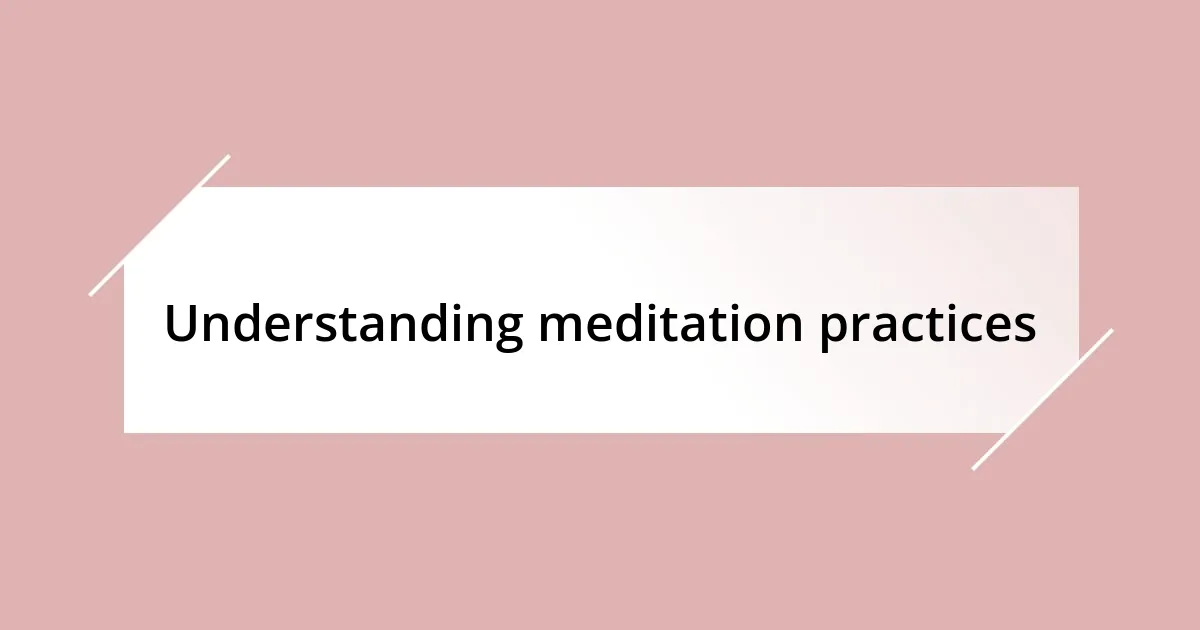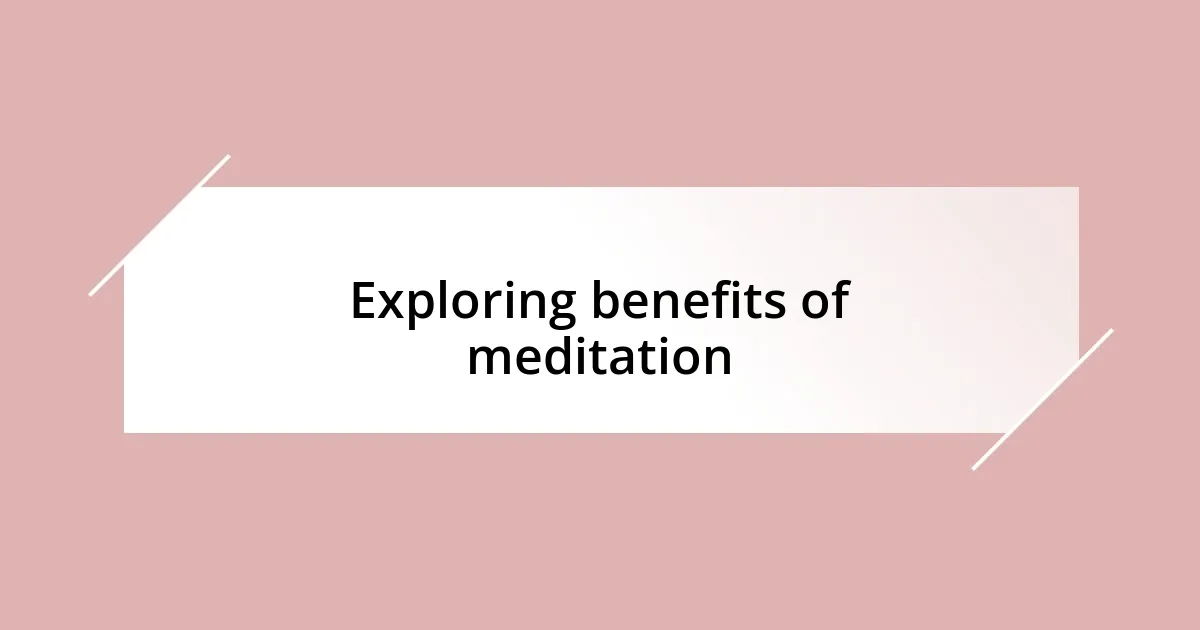Key takeaways:
- Meditation practices, such as guided visualization and loving-kindness meditation, cultivate awareness, emotional well-being, and personal connection.
- Regular meditation enhances mental clarity, emotional balance, and physical well-being, improving decision-making and stress management.
- Creating a consistent meditation routine and a comfortable space significantly enhances the practice, making it a committed part of daily life.
- Insights from meditation include understanding thoughts as transient, the power of presence, and the importance of acknowledging emotions for deeper self-compassion.

Understanding meditation practices
When I first delved into meditation, I was bewildered by the myriad of practices available — from mindfulness to transcendental meditation. Each method offers unique approaches, but the core intention remains the same: to cultivate awareness and presence. Have you ever taken a moment to pause in a hectic day and just breathe? It’s incredibly grounding.
One practice that resonated with me was guided visualization. I remember sitting in a quiet room, headphones on, listening to soothing words that painted vibrant landscapes in my mind. It felt as if the chaos of the outside world faded away, and I was transported to a serene beach. This experience taught me that meditation can be more than just silence; it can be an adventure within oneself.
As I explored deeper, I began to appreciate the structure of various techniques, like loving-kindness meditation. This practice encourages you to send compassion to others, which surprisingly started to nurture my own heart. It makes me wonder: can a simple shift in thought really amplify our emotional well-being? I truly believe it can, as it’s transformed my perspective on connection and empathy.

Exploring benefits of meditation
Meditation has a remarkable ability to enhance mental clarity and reduce clutter in our minds. I recall an afternoon when stress felt overwhelming, and after just a few minutes of deep breathing, my thoughts began to align like pieces of a puzzle falling into place. That clarity transformed how I approached my challenges, allowing me to tackle them head-on instead of feeling lost.
Moreover, I’ve found that regular meditation fosters emotional balance, which I didn’t realize until I navigated a particularly tumultuous period in my life. During those times, I noticed that simply closing my eyes and focusing on my breath helped me regain my composure. This practice taught me how important it is to take a step back and assess my feelings, leading to healthier responses and interactions with others.
Lastly, the physical benefits shouldn’t be overlooked. I remember a notable experience after a few weeks of daily meditation; my body felt lighter, and the tension I usually carried in my shoulders was gone. I’ve learned that a calm mind often translates to a relaxed body, creating a positive feedback loop that encourages both mental and physical well-being.
| Benefit | Description |
|---|---|
| Mental Clarity | Enhances focus and reduces mental clutter, allowing for better decision-making. |
| Emotional Balance | Helps manage stress and improves emotional regulation during difficult times. |
| Physical Well-being | Reduces tension in the body, promoting a sense of relaxation and overall health. |

My initial struggles with meditation
In the beginning, the journey into meditation felt like walking through a foggy maze. I often found my mind racing, filled with thoughts that refused to quiet down. During my first attempts, sitting still felt like an uphill battle, especially when my to-do list seemed to scream for my attention. I would fidget and glance at the clock, wondering if I was doing it “right.” It was frustrating to feel like I wasn’t getting anywhere when so many others spoke about their peaceful experiences.
- I struggled with restlessness, constantly shifting in my seat.
- The distractions of daily life loomed large, making focus elusive.
- My expectations created pressure, leading to disappointment instead of relaxation.
Amid these challenges, I remember one session when I decided to focus solely on my breath. As I inhaled deeply, a wave of anxiety washed over me, and I almost quit. Instead, I leaned into that discomfort. It was a pivotal moment. I learned that meditation isn’t about perfection; it’s about embracing the experience, even the chaotic feelings. That realization was a turning point for me, moving from frustration to acceptance.

Techniques that enhanced my clarity
Meditation techniques played an essential role in finding my clarity. One significant approach was the practice of guided meditations. I remember tuning into a soothing voice, which helped me focus my wandering mind. These sessions felt like a gentle hand guiding me through the chaos, allowing me to visualize my thoughts and emotions, and over time, I noticed that I could quickly access that calm state on my own.
Another technique that brought clarity was mindful walking. The simple act of focusing on each step and the sensations in my body shifted my perspective. I recall a particularly stressful day when I stepped outside and felt the cool breeze against my skin while concentrating on my footfalls. That connection to the present moment cleared a fog of worry that had been clouding my thoughts. Have you ever tried to bring mindfulness into your everyday activities? It can be incredibly grounding.
Lastly, journaling after my meditation sessions became a powerful tool. I began jotting down insights that emerged during my practice. There was one day I wrote about a lingering fear that surfaced, allowing me to confront it head-on. This act of reflection not only solidified those moments of clarity but also helped me track my personal growth. It’s remarkable how externalizing thoughts can cut through confusion and provide direction, don’t you think?

Creating a meditation routine
Creating a meditation routine was a game changer for me. Initially, I struggled with consistency; my sessions were scattered. But I noticed that when I carved out a specific time each day, even for just five minutes, it became easier to settle into the practice. Can you relate to that? Establishing that routine turned meditation from an option into a commitment.
As I deepened my practice, I added variety to keep things fresh. Some days, I’d meditate in silence, while others, I’d use calming music or a favorite app. I remember one week where I experimented with morning meditations while sipping my tea. Those quiet moments felt sacred, allowing me to greet the day with a serene mindset. It’s fascinating how a simple adjustment can enhance your experience, isn’t it?
I also found that creating a comfortable space was essential. I dedicated a corner of my room, adorned with candles and cushions, which felt inviting and soothing. The first time I lit a candle and sat down there, a wave of calm washed over me. It was a reminder that this time was mine. How do you currently create your meditation space? Little changes can transform not just the practice but your entire mindset going into it.

Insights gained through meditation
Meditation offered me profound insights, particularly about the nature of my thoughts. One day, while I was observing the flow of my breath, I became acutely aware of how often I drifted into harsh self-judgment. I felt this sense of relief wash over me as I realized these thoughts didn’t define me; they were just passing clouds in the vast sky of my mind. Have you ever experienced a moment where you saw your thoughts for what they truly are—just fleeting ideas rather than your true essence?
Another surprising lesson from my practice was the power of presence. During a particularly chaotic week, I sat down for my session, focusing intently on the sounds around me. I remember feeling overwhelmed by the noise of the world, yet within that chaos, I discovered this serene stillness. This contrast illuminated how I often carried stress with me, unaware that peace was always accessible. Isn’t it fascinating how meditation can reveal layers of ourselves we didn’t even know existed?
I also found clarity in understanding my emotions better. There was one session where I suddenly felt a wave of sadness rise up. Instead of pushing it away, I allowed myself to simply sit with that feeling. By acknowledging it, I unlocked insights into my emotional triggers and learned how to respond rather than react. This practice of observation helped me cultivate a deeper compassion toward myself. Have you ever just sat with your feelings, letting them unfold like petals of a flower? It’s in that space of acceptance that true clarity thrives.

Maintaining clarity in daily life
Maintaining clarity in daily life demands a conscious effort to integrate mindfulness beyond meditation sessions. For me, learning to pause throughout the day has been transformative. I often take a moment, even just a few breaths, to reconnect with myself whenever I feel overwhelmed. This simple practice helps me regain focus and clarity, reducing the emotional noise that can cloud judgment. Have you tried stepping back for a breath when life gets hectic?
Another important aspect is setting healthy boundaries. I realized that saying “no” sometimes is vital to protect my mental space. When I consciously chose to limit distractions, like social media or excessive commitments, I found that I could approach each task with greater clarity. I remember one week when I unplugged from my phone during evenings—I felt a significant shift in my overall well-being. How do you prioritize your mental space?
Finally, I make it a habit to reflect on my day, often during my evening tea. This ritual allows me to process my experiences, celebrating small wins and learning from challenges. I recall one night when I felt particularly scattered; writing down my thoughts helped me clarify my goals for the next day. It was empowering to see everything laid out on paper, giving me both insight and direction. Reflection is a powerful tool, isn’t it?














